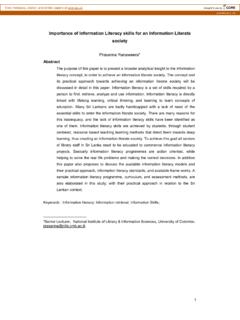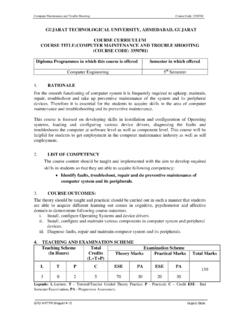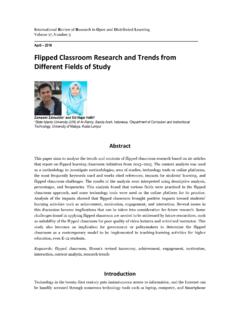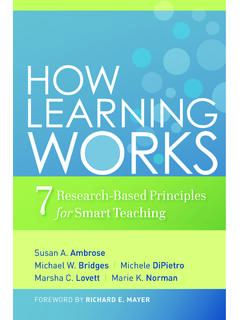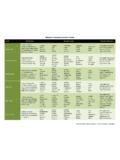Transcription of Unit Plan: Mixtures and Solutions Fifth Grade
1 Unit Plan: Mixtures and Solutions Fifth Grade Emilie Petry Madison Csizmadia SPE 304 Dr. Giannola & Dr. McConville Overall Objective/Introduction This unit on the topic of Mixtures and Solutions will introduce our students to the different concepts and characteristics of Mixtures and Solutions . By the end of this unit, students will be able to differentiate Mixtures and Solutions and dictate whether they are homogeneous or heterogeneous. Learning about the makeup of Mixtures and Solutions provides us with knowledge about how things go together and how they can be taken apart. Throughout this unit, our students will explore and see firsthand how Mixtures and Solutions are relevant in real life. The activities that we included in this unit will involve the use of several different modalities that creates interaction amongst the students.
2 Cooperation is important for our class because the room is rather small. In order to make the best use of our space, we will use small groups for most activities. Using small groups will also help with not overwhelming our students with the amount of work they have to do, as well as keeping their attentions by only having them focus on one thing when moving from station to station. The levels of the students in the class is varied greatly. The students range from advanced proficient to below average. Some students are classified, so cooperative and group work is essential for the success of the class. These students come from middle to high class families. Socioeconomic status does not affect the classroom dynamics much since most of the students come from families of similar socioeconomic status.
3 This unit will be taught across subject areas: during social studies the students will explore how different Mixtures and Solutions are used in distinct ways around the world in various regions. During math we will have the students sort different components of trail mix to find the percentages of each component, for example; the mix is 10% m&ms and 20% peanuts. During reading we will give vocabulary to the students pertaining to Mixtures and Solutions that they will use on their game boards. During this time, the students will have to discuss the differences between Mixtures and Solutions . We will have a special activity that is called a rainbow in a bottle. This will show the students which liquids mix together to make Solutions or stay separated.
4 There will be an activity where students create game boards in art and science where the students will research Mixtures or Solutions to create ten questions they can ask during their game. We will listen to a song that will help the students to remember the characteristics and differences of separating Mixtures and Solutions . This song will be played each morning and will help the information better stay fresh in the students memories. This unit is a scientific topic but will be taught throughout all content areas for the students to make connections and have real life examples of the materials being taught. Rationale We will teach this unit as part of the Fifth Grade science curriculum. This unit is important to teach because it is an introduction to Chemistry which will start to be taught in middle school.
5 Mixtures and Solutions are part of everyday life which makes the topic relatable and obtainable to keep student engagement. The activities pertaining to Mixtures and Solutions will not be solely done during science class, but instead the unit will also be incorporated into social studies, art, math, vocabulary, and music. In order to deepen the students understanding of Mixtures and Solutions and how they are used in everyday life, it is important to teach the concepts across content areas. We will begin this unit with an introductory and exploratory activity using trail mix, which represents a homogeneous and heterogeneous mixture. This activity will give the students a real life example of a mixture and how it differs from a solution before having any knowledge on what a mixture or solution is.
6 Doing this activity before instruction on Mixtures and Solutions will help the students to to make connections and relate to the lessons on Mixtures and Solutions after the activity is complete. These activities also link science and math content by using ratios while determining characteristics about Mixtures . Following the introductory activities and lessons, we will begin incorporating Mixtures and Solutions into the classroom everyday across content areas. After the introductory activity has been completed, there will be a lesson in social studies that explores how Mixtures and Solutions are used all around the world. The students will research an item from their own culture and explain if it is a mixture or a Solutions and why.
7 This will link the concept of Mixtures and Solutions to their own life, making the material more meaningful to the students. The next lesson teaches the concept of separating Mixtures and Solutions through a song called the Mixtures Separating Song. This remix explains the different processes of separating Mixtures and Solutions using scientific vocabulary. Here students will be able to hear the vocabulary used in context before being taught the different processes. The following day we will have our special activity during the science period to deepen the understanding of separating Mixtures and Solutions . This activity will be called Rainbow in a Bottle and will be a group activity to incorporate cooperation along with making connections to previous lessons.
8 In closure of this unit, the students will create a game board that is a trivia game using vocabulary for Mixtures and Solutions , creating this will not only let the students be creative with their learning, but it will also reinforce the materials taught throughout the unit. The day before the end of the unit, the students will be able to play each other's game boards as the closing to the unit. At the end of the unit there will also be a unit project as a long term formative assessment that will measure the understanding the students have for Mixtures and Solutions after all the lessons are completed. The standards that our unit is based off of are from the Next Generation Science Standards, Common Core Standards, and CEC Standards.
9 5-PS1-4. Conduct an investigation to determine whether the mixing of two or more substances results in new substances. 5-PS1-3. Make observations and measurements to identify materials based on their properties. 5-PS1-2. Measure and graph quantities to provide evidence that regardless of the type of change that occurs when heating, cooling, or mixing substances, the total weight of matter is conserved. Draw on information from multiple print or digital sources, demonstrating the ability to locate an answer to a question quickly or to solve a problem efficiently. Conduct short research projects that use several sources to build knowledge through investigation of different aspects of a topic. Adaptations In our class of 25 students, there are 3 students with classifications and IEPs.
10 All of these students are mainstreamed in our classroom for every subject except reading and writing, where they are pulled out into a self-contained classroom. During science, social studies, and math there are two paraprofessionals in the classroom aiding to the students with special needs and those who are struggling with the content being taught. We differentiated this unit to meet the needs of all our students with and without classifications. George is a ten year old boy with aspergers, he has above average intelligence in subjects such as math and science. George has difficulties working with his peers and does not like help from the paraprofessionals. George thrives when given independent work and enjoys figuring concepts out on his own.
